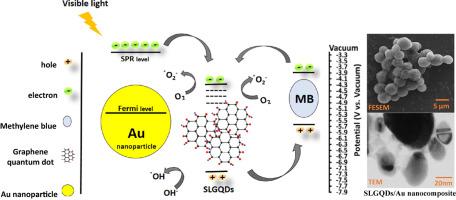Journal of Alloys and Compounds ( IF 6.2 ) Pub Date : 2021-06-21 , DOI: 10.1016/j.jallcom.2021.160904 Mohamad Taghi Dejpasand , Esmaiel Saievar-Iranizad , Amir Bayat , Saeed Rahemi Ardekani

|
Single-layer graphene quantum dots and gold (SLGQDs/Au) nanospheres composite was synthesized by hydrothermal and photochemical methods. Single-layer graphene quantum dot was synthesized by glucose precursor via hydrothermal method and SLGQDs/Au nanocomposite was prepared by adding HAuCl4 under UV irradiation. Characterization of sample was performed using XRD, Raman, FESEM, UV–vis spectroscopy and PL analysis. The quantum yield of SLGQDs/Au composite was calculated. The role of surface plasmon resonance (SPR) of gold nanoparticles in quantum yield reduction and the effect of quantum yield on photodegradation was discussed. Using the optimal sample, a photocatalyst test was performed on methylene blue, which near 90% photocatalytic degradation was achieved under visible light irradiation in 120 min. Compared to bare GQD the high photocatalytic efficiency of composite could be due to the presence of SPR level of Au nanoparticles between highest occupied molecular orbital (HOMO) and lowest unoccupied molecular orbital (LUMO) of SLGQDs. Under light irradiation, SLGQDs and Au nanoparticles absorb visible light energy. By absorbing the photons, the electrons of SLGQDS could be excited to LUMO band and leave holes in HOMO band. Spontaneously the emitted photons excite the Fermi level electrons of Au nanoparticles to the SPR state. Created SPR level can suppress electron-holes recombination. Then the photo-exited electrons react with dissolved oxygen to generate ° O2− and ° OH radicals meanwhile, the holes could oxide OH− into OH°. Created radicals which are strong oxidants degrade the pollutants.
中文翻译:

可见光照射下单层石墨烯量子点/金纳米球对亚甲基蓝的表面等离子体诱导光降解
通过水热和光化学方法合成了单层石墨烯量子点和金(SLGQDs / Au)纳米球复合材料。葡萄糖前驱体水热法合成单层石墨烯量子点,加入HAuCl 4制备SLGQDs/Au纳米复合材料在紫外线照射下。使用 XRD、拉曼、FESEM、UV-vis 光谱和 PL 分析对样品进行表征。计算了 SLGQDs/Au 复合材料的量子产率。讨论了金纳米粒子的表面等离子体共振 (SPR) 在量子产率降低中的作用以及量子产率对光降解的影响。使用最佳样品对亚甲基蓝进行光催化测试,在可见光照射下 120 分钟内实现了近 90% 的光催化降解。 与裸 GQD 相比,复合材料的高光催化效率可能是由于存在 SPR 水平的SLGQDs的最高占据分子轨道(HOMO)和最低未占据分子轨道(LUMO)之间的Au纳米颗粒。在光照射下,SLGQDs 和 Au 纳米颗粒吸收可见光能量。通过吸收光子,SLGQDS 的电子可以被激发到 LUMO 带并在 HOMO 带留下空穴。发射的光子自发地将 Au 纳米粒子的费米能级电子激发到 SPR 状态。创建的 SPR 能级可以抑制电子空穴复合。然后光激发电子与溶解氧反应生成°O2 -和OH°自由基与此同时,孔可以氧化物OH -为OH°。产生的自由基是强氧化剂,可降解污染物。


























 京公网安备 11010802027423号
京公网安备 11010802027423号